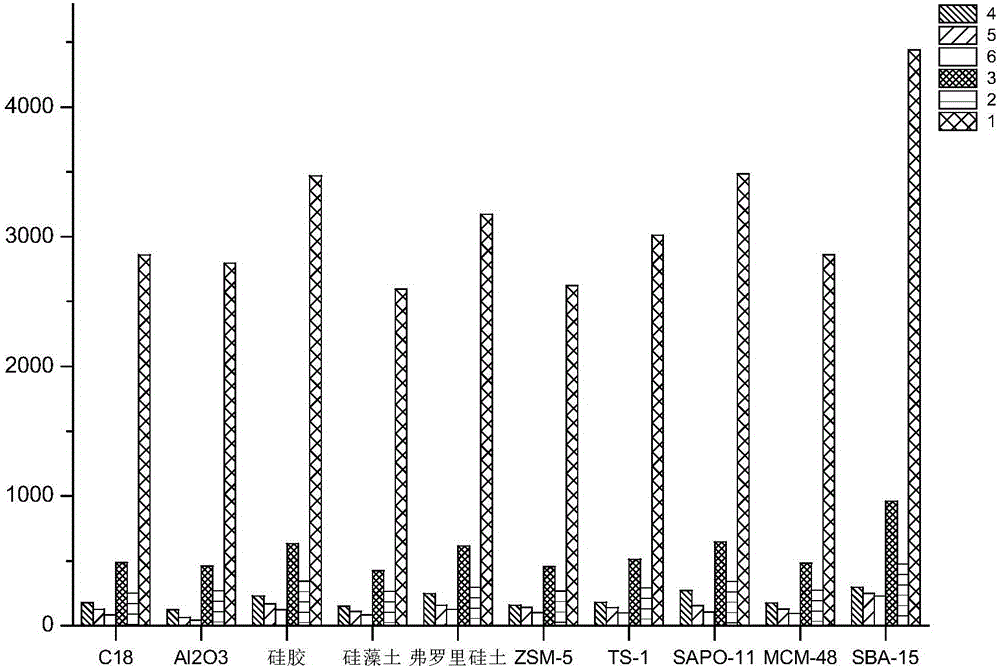Extracting and detecting method for flavonoid in radix sophorae subprostratae
A technology of flavonoids and detection methods, which is applied in the field of analysis and detection methods of flavonoids in root medicinal materials, can solve the problems of environmental pollution, large amount of eluent, etc., and achieve high extraction efficiency, low cost, and high efficiency.
- Summary
- Abstract
- Description
- Claims
- Application Information
AI Technical Summary
Problems solved by technology
Method used
Image
Examples
Embodiment 1
[0067] Embodiment 1: Sample pretreatment
[0068] 1. High performance liquid chromatography conditions: Agilent Technologies 1290 Infinity. Column: EclipsePlus C 18 RRHD, 1.8μm, 2.1×50mm, detection wavelength: 280nm, column temperature: 40℃, injection volume: 0.8uL, flow rate: 0.4mL min -1 , mobile phase: A: acetonitrile, B: 0.1% formic acid in water. Gradient elution: 0~30min, 10%~40%A; 30~40min, 40%~50%A; 40~50min, 50%~56%A; 50~60min, 56%~76%A; 60~ 70min, 76%~95%A; 70~75min, 95%~95%.
[0069] 2. Optimization of extraction conditions: investigate different adsorbents C 18 、Al 2 o 3 , silica gel, diatomaceous earth, florisil, ZSM-5, TS-1, SAPO-11, MCM-48, SBA-15, the ratio of different mountain bean root medicinal powder and molecular sieve is 2:1, 3:2, 1:1, 1:2, 1:3, different grinding time 90s, 120s, 150s, 180s, 210s, different eluents methanol, ethanol, acetonitrile, acetone, 50% methanol-50% acetonitrile, 50% methanol-50 Effects of % ethanol and different volumes o...
Embodiment 2
[0077] Embodiment 2: Separation condition optimization
[0078]1. Capillary Electrokinetic Chromatography Conditions: Agilent Technologies 7100Capillary Electrophoresis, with UV detector; Column: Uncoated Quartz Capillary (56cm×50μm, i.d., Hebei Yongnian Ruifeng Chromatographic Device Co., Ltd.). The operating voltage of reverse microemulsion capillary electrokinetic chromatography is -15~-30kv (preferably -20kv), the detection temperature is 20~35°C (preferably 25°C), the conventional voltage sampling conditions: -20kv, 5s; the detection wavelength is 280nm. Microemulsion consists of: SDS 0.8% ~ 3.0% (w / v), co-surfactant 6.6% (w / v), oil phase 0.5% (w / v), organic additives 15% (w / v), hand Resolving agent 0~20mM, buffer 20mM pH 2NaH 2 PO 4 aqueous solution. More preferably: 1% (w / v) SDS, 6.6% (w / v) n-butanol, 0.5% (w / v) ethyl acetate, 15% (w / v) acetonitrile, 10 mM sulfobutyl-β - Sodium cyclodextrin, 20mM NaH 2 PO 4 (pH 2) buffer, form a microemulsion after ultrasonication...
Embodiment 3
[0092] Example 3: Optimization of FASI-MEEKC online enrichment conditions
[0093] 1. The influence of the pH value and concentration of the sample matrix
[0094] The degree of dissociation of the analytes will significantly affect the enrichment effect of FASI when electrodynamic sampling is used. Flavonoids are difficult to dissociate under neutral or acidic conditions, and the enrichment effect is poor. Therefore, an alkaline sample matrix is selected. The present invention investigates the borax buffer solution with pH 7.5-9.5 as the sample matrix, and finds that the peak shape is good and the enrichment effect is the best at pH 8.5.
[0095] The concentration of borax buffer affects the ionic strength and conductivity of the sample matrix. The influence of the sample matrix concentration from 0.1 to 10mol / L pH 8.5 on the enrichment effect was investigated. The results show that the detection sensitivity of the sample is obviously improved in the lower concentration so...
PUM
| Property | Measurement | Unit |
|---|---|---|
| pore size | aaaaa | aaaaa |
| crystallinity | aaaaa | aaaaa |
Abstract
Description
Claims
Application Information
 Login to View More
Login to View More - R&D Engineer
- R&D Manager
- IP Professional
- Industry Leading Data Capabilities
- Powerful AI technology
- Patent DNA Extraction
Browse by: Latest US Patents, China's latest patents, Technical Efficacy Thesaurus, Application Domain, Technology Topic, Popular Technical Reports.
© 2024 PatSnap. All rights reserved.Legal|Privacy policy|Modern Slavery Act Transparency Statement|Sitemap|About US| Contact US: help@patsnap.com










